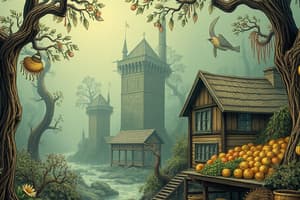Podcast
Questions and Answers
What is the environment?
What is the environment?
The sum total of all our surroundings, including all of the living and nonliving things with which we interact.
Which of the following are renewable resources? (Select all that apply)
Which of the following are renewable resources? (Select all that apply)
- Solar energy (correct)
- Coal
- Fresh water (correct)
- Natural gas
What defines nonrenewable resources?
What defines nonrenewable resources?
A resource of economic value that cannot be readily replaced by natural means on a level equal to its consumption.
Define biodiversity.
Define biodiversity.
What is sustainability?
What is sustainability?
What is an ecological footprint?
What is an ecological footprint?
Who was John Muir?
Who was John Muir?
What significant book did Rachel Carson write?
What significant book did Rachel Carson write?
From the lake food web components, one food chain is: Macrophytes--Great pond snail-- ____
From the lake food web components, one food chain is: Macrophytes--Great pond snail-- ____
A food chain example is: Planktonic Algae--Daphnia-- ____--Pike
A food chain example is: Planktonic Algae--Daphnia-- ____--Pike
How many food chains can be constructed from the provided information?
How many food chains can be constructed from the provided information?
What type of consumer is a mosquito larva?
What type of consumer is a mosquito larva?
Flashcards are hidden until you start studying
Study Notes
Environmental Science Key Terms
-
Environment: Encompasses all living and nonliving surroundings and their interactions within ecosystems.
-
Renewable Resources: Natural resources that are replenished naturally, including oxygen, fresh water, solar energy, timber, and biomass.
-
Nonrenewable Resources: Economic resources that take billions of years to form and cannot be replaced at the rate they are consumed; examples include fossil fuels like oil, natural gas, and coal.
-
Biodiversity: Refers to the variety of life forms in a specific area, accounting for species diversity, genetic variation, population diversity, and community diversity.
-
Sustainability: An environmental science principle promoting responsible living to preserve Earth's systems and natural resources for future generations.
-
Ecological Footprint: Measures the total land and water area required to support a population's resource consumption and waste disposal/recycling needs.
Key Historical Figures
-
John Muir (1883-1914): Scottish immigrant and conservationist known for his advocacy for the preservation of wilderness, especially Yosemite Valley. He emphasized both ecocentric and anthropocentric values of nature.
-
Rachel Carson (1907-1964): Environmental activist and author of "Silent Spring" (1962), a pivotal work highlighting the environmental and health impacts of pesticides and industrial chemicals.
Food Web Components
- Food Chains Examples:
- Macrophytes → Great pond snail → Carp
- Detritus → Diving Beetle
- Planktonic Algae → Daphnia → Three-spined stickleback → Pike
- Planktonic Algae → Daphnia → Asplanchia
- Planktonic Algae → Daphnia → Dragonfly larva → Three-spined stickleback → Pike
- Planktonic Algae → Daphnia → Hydra → Dragonfly larva → Three-spined stickleback → Pike
- Planktonic Algae → Daphnia → Hydra → Herbivorous water beetle
- Planktonic Algae → mosquito larva → Diving beetle
- Planktonic Algae → mosquito larva → Three-spined stickleback → Pike
- Macrophytes → Carp
Ecological Relationships
-
Food Web Construction: Connects various food chains to illustrate energy flow and relationships among species in a community.
-
Trophic Levels Notation:
- Producers (P), Herbivores (H), Carnivores (C), Omnivores (O)
- Consumer classification as first to fourth order (1-4) based on their position in the food chain, excluding producers.
This framework helps in understanding the complex interactions within ecosystems and the importance of sustainability and conservation.
Studying That Suits You
Use AI to generate personalized quizzes and flashcards to suit your learning preferences.




